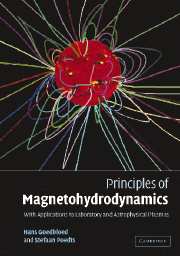Book contents
- Frontmatter
- Contents
- Preface
- Part I Plasma physics preliminaries
- Part II Basic magnetohydrodynamics
- 4 The MHD model
- 5 Waves and characteristics
- 6 Spectral theory
- 7 Waves and instabilities of inhomogeneous plasmas
- 8 Magnetic structures and dynamics
- 9 Cylindrical plasmas
- 10 Initial value problem and wave damping
- 11 Resonant absorption and wave heating
- Appendices
- References
- Index
8 - Magnetic structures and dynamics
Published online by Cambridge University Press: 22 February 2010
- Frontmatter
- Contents
- Preface
- Part I Plasma physics preliminaries
- Part II Basic magnetohydrodynamics
- 4 The MHD model
- 5 Waves and characteristics
- 6 Spectral theory
- 7 Waves and instabilities of inhomogeneous plasmas
- 8 Magnetic structures and dynamics
- 9 Cylindrical plasmas
- 10 Initial value problem and wave damping
- 11 Resonant absorption and wave heating
- Appendices
- References
- Index
Summary
Plasma dynamics in laboratory and nature
In this chapter we will make an excursion to the vast territory of magnetic structures and dynamics of the different plasmas encountered in the solar system, in particular the Sun and the planetary magnetospheres. While laboratory plasma confinement for the eventual goal of energy production also provides a rich diversity of magnetic structures, their topology and dynamics is always constrained by the presence of a fixed set of coils with programmed currents that should control the spatial and temporal behaviour of the magnetic fields. The reason is clear: for the success of thermonuclear energy production, plasma dynamics and complexity are not really desired. The best thing would be to extract energy from a plasma that just sits quietly inside a toroidal vessel and the engineering approach to plasma confinement is to try to approach this ideal as closely as possible. The history of thermonuclear fusion research demonstrates impressive progress along this line but also the immense obstacles, due to complex plasma dynamics, that have to be overcome. In astrophysical plasmas, on the other hand, no such human engineering constraints exist: plasmas and their associated magnetic structures appear to be almost free to exhibit the bewildering variety of different dynamics that are observed on virtually all length and time scales.
Space missions in the second part of the twentieth century have played an important role in demonstrating the different magnetic structures and dynamics of plasmas in the solar system.
Information
- Type
- Chapter
- Information
- Principles of MagnetohydrodynamicsWith Applications to Laboratory and Astrophysical Plasmas, pp. 384 - 430Publisher: Cambridge University PressPrint publication year: 2004
